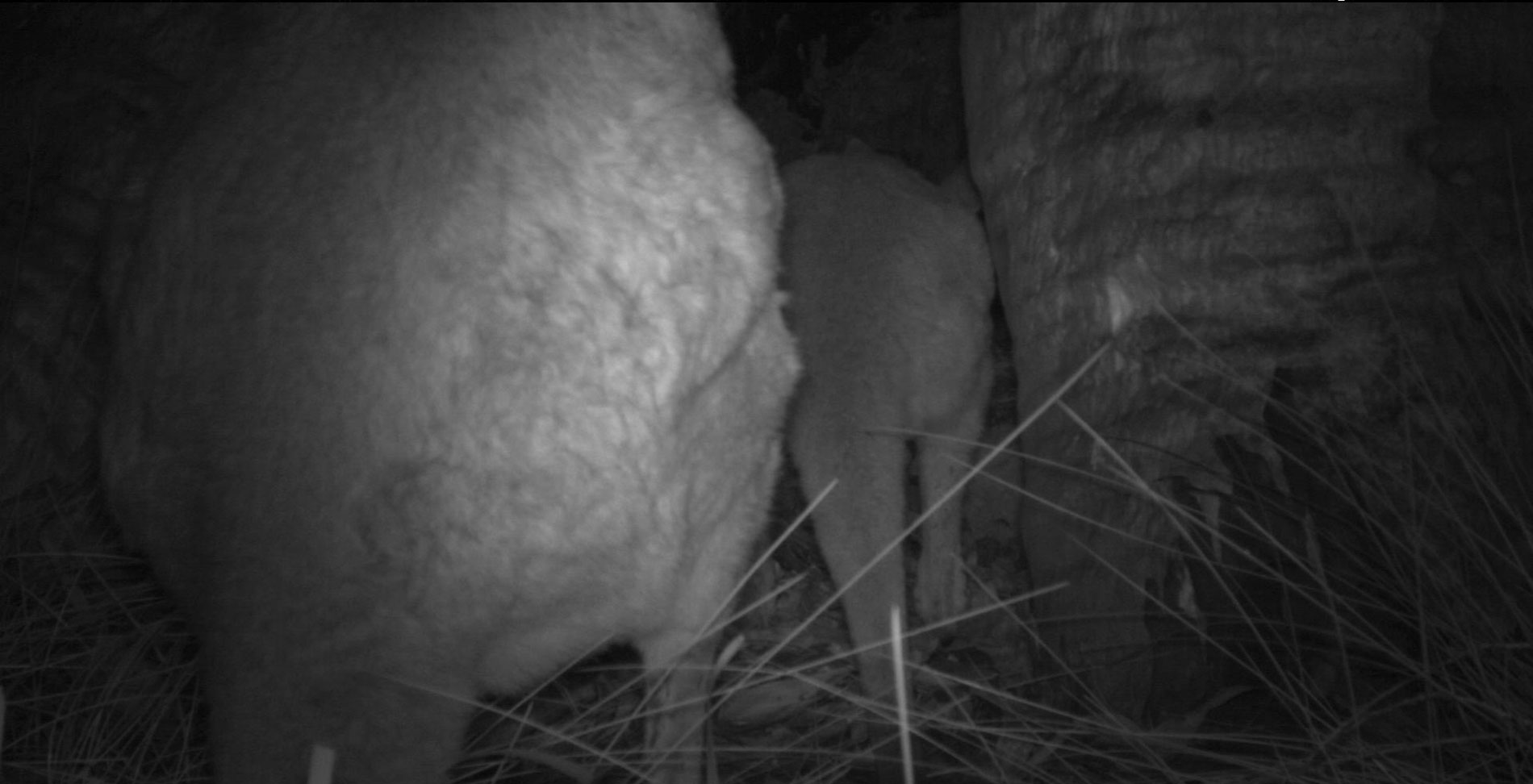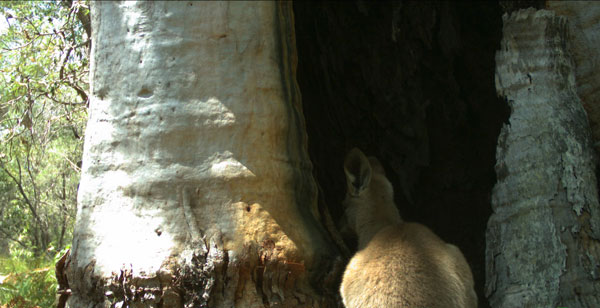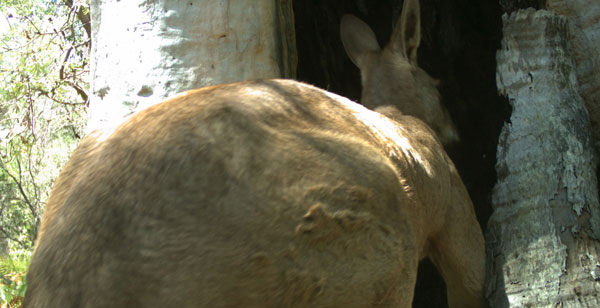Upon flicking through and sorting hundreds of photos from fauna cameras recently deployed on a Land for Wildlife / Voluntary Conservation Agreement (VCA) property at Weyba Downs, I noticed a curious behaviour exhibited by Eastern Grey Kangaroos (Macropus giganteus).
I had cameras set up facing hollows at the base of two old Scribbly Gums (Eucalyptus racemosa) at different locations on the property. Scattered among the pictures of Echidnas, Koalas, Lace Monitors, a Red-bellied Black Snake, Yellow-footed Antechinus and Common Brushtail Possums were pictures of Eastern Grey Kangaroos repeating the same behaviour. They were meticulously investigating the insides of hollow trees; the juveniles would even completely disappear into the hollows for short periods!

A joey goes inside the hollow whilst Mum supervises.
Eastern Grey Kangaroos eat a diet of up to 98% grass, but with no grass (or any plant for that matter) inside the hollows, I was at a bit of a loss as to what they were doing. Wallabies are known to consume a wide range of underground-fruiting fungi, and rotting ground hollows such as the ones being photographed would be a prime location for many fungal species. However, unlike wallabies, mycophagy (fungus- eating) has not been extensively reported in Eastern Grey Kangaroos.
Studies have shown that scent marking is important for indicating social status in Eastern Grey Kangaroos and may also be important for predator recognition. However our in-office wildlife expert, Nick Clancy, thought that the Eastern Grey Kangaroos were demonstrating too much interest in the hollows for scent marking.

A joey ventures into the hollow on its own.

A large male Eastern Grey Kangaroo tries to squeeze his way into the hollow.
I sent the series of photos to the Queensland Museum and some local ecologists for further analysis. A few weeks later, I was delighted to receive a reply from behavioural ecologist Associate Professor Anne Goldizen from the University of Queensland. Anne suggested that the kangaroos were obtaining salt or some other desired mineral by eating the soil.
Around the world, geophagy (consumption of soil) is widely observed and studied in herbivorous mammal species. Until recently, geophagy had never been reported in any marsupial species. In 2013, Emily Best along with Anne Goldizen and Julia Joseph published the first report of Eastern Grey Kangaroos using natural salt licks at Sundown National Park to supplement their salt and mineral requirements. The researchers found that visitations by kangaroos to salt licks increased depending on their reproductive state. Lactating females and large males spent the most time at the lick. To date, this behaviour has not been detected in any other intensively studied kangaroo population across Australia.
Now, I know what you’re thinking, “Why would the soil inside a hollowed out tree have more salt or minerals than any other patch of dirt?”
Kieran Aland from the Queensland Museum offered an answer:
“Rain-protected soil containing ash in the base of a tree hollow would certainly retain a higher concentration of soluble elements than surrounding rain-washed soil outside of the hollow.”
Other suggestions received were that the kangaroos were seeking trace elements in the ash at the base of the hollow, or that the roos were eating mineralised clay/ termite nesting material within the hollow.
Armed with a fascinating hypothesis, I will be back out to Weyba Downs with my fauna cameras to try and capture video footage from inside the hollows to confirm what this behaviour is all about. I just hope the resident Red-bellied Black Snake doesn’t get too upset with me!
References & Further Reading
Best EC, Joseph J & Goldizen AW (2013) Facultative geophagy at natural licks in an Australian marsupial. Journal of Mammalogy, 94(6) 1237-1247.
Claridge AW, Trappe JM & Claridge DL (2002) Mycophagy by the swamp wallaby (Wallabia bicolour). Wildlife Research, 28(6) 643-645.
Jackson S & Vernes K (2010) Kangaroo: A portrait of an Extraordinary Marsupial. Allen & Unwin.
Ramp D, Russell BG & Croft DB (2005) Predator scent induces differing responses in two sympatric marcopodids. Australian Journal of Zoology, 53(2) 73-78.
Salamon M, Davies NW & Stoddart M (1999) Olfactory Communication in Australian Marsupials with Particular Reference to Brushtail Possum, Koala and Eastern Grey Kangaroo. In: Advances in Chemical Signals in Vertebrates (Eds. Johnston et. al.), Springer.
Taylor RJ (1983) The diet of the eastern grey kangaroo and wallaroo in areas of improved and native pasture in the New England Tablelands. Australian Wildlife Research, 10(2) 203-211.
Article by Danielle Crawford Land for Wildlife Officer Sunshine Coast Council

I am on a beach daily with kangaroos,they eat grass on the sand dunes ,which would be covered in salt spray .They often go into the surf ,not deep ,and I often see them licking the salt water .I thought this was the same as farmers give their cattle salt blocks .
I’ve been caring for an orphaned Agile Wallaby in the NT, she’s now around 12mths old and I’ve noticed several times licking the pool tiles around a salt water swimming pool as well as drinking the water which has been a concern, she also licks my skin which I figured was for the salt. I’m relieved to be reading this article and wondering if I should put out a salt block. She feeds mostly on green grass on the property and macropod pellets, she is being weaned is down to one bottle feed of Wambaroo 7 formula a day.
What do you think.
Hi I’m very curious as to what your responses were to this? I am caring for a pademelon Joey and he is always licking us as if he is lacking in some salts. I’ve been wondering whether to put a salt lick out for him but I’ve searched the internet for information and there’s nothing!
In the Torrington State Conservation Area ther are a number of old mining sites where both wallabies and kangaroos ‘mine’ clay ouT of particular strata within the mine walls. While I have not seen them eating this clay, I have always assumed that this was what they were doing.
Yes, that’s what they are doing. Have come across it – normally after rain. And it’s usually in gold bearing clay’s – being highly minerialised
I’m in the Snowy mountains at a forested property with natural bog clearings where grass grows abundantly in the tussock flat. Eastern greys and feral deer graze together by the Little Thredbo River, and there’s a small rock in the grass by the creek. In the three days I’ve been here, I’ve noticed deer and roos diligently licking this single black rock. Like you, at first I thought it might be a scent marker, but there’s so much licking that it doesn’t seem likely to me. I’m watching now a deer and a roo both licking the same rock together. And like you, I’m inclined to conclude there’s something desirable within the rock. There are massive rocks all around the property, but I’ve only noticed this one rock gaining attention. And it looks different from the rest.
I prospect in the Mudgee region of NSW. I use to come across these small holes in minerialized clay wall – after rain. It took me a few months to workout – but Roos/Wallabies were digging out & eating that clay….
We are camping near Tumut and last night we seen around 30 Eastern greys licking the clay at the edge of the lake at a certain point, they stayed there for hours.
We’re camping near Lake Eucumbene and each night kangaroos have been licking the sidesteps and doors of our car. One was even licking the fender liner and tyre! The only thing we can figure is that they’re licking salt that the car has picked up from road salting near the ski fields. But we could be wrong… Has anyone else seen this behaviour?